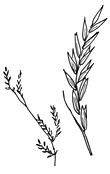
Description: Perennials with creeping rhizomes; culms usually erect, smooth.
Leaves with sheath keeled, closed, later splitting; ligule membranous, 3–6 mm long; blade folded in bud, flat, margins rough, glabrous.
Inflorescence open or contracted.
Spikelets solitary, pedicellate, 5–30 mm long, narrow-oblong, slightly compressed, disarticulating above the glumes and between each lemma; 4–20 bisexual florets. Glumes ovate to oblong, unequal, persistent, membranous, 1–3-nerved. Lemmas elliptic to oblong, rounded on the back, overlapping, exserted from glumes, firm with a thin translucent apex, obtuse or subulate, usually 7-nerved, numerous. Palea equal to or longer than the lemma, 2-keeled.
Distribution and occurrence: World: c. 40 species, temperate regions of Europe, Asia, North America, Australia & New Zealand. Australia: 5 species (2 species native, 3 species naturalized), all States except N.T.
Text by S. W. L. Jacobs & K. L. McClay
Taxon concept:
| | Key to the species | |
| 1 | Lemmas 2–5.5 mm long, rarely 6 mm long | 2 |
| Lemmas 6–10 mm long | 3 |
| 2 | Spikelets 12–25 mm long with 8–15 florets; lemmas appear toothed at the tip; panicle usually with less than 50 spikelets | Glyceria declinata |
| Spikelets 5–10 mm long with 4–8 florets; lemmas obtuse not toothed; panicle with 50–100 spikelets
Back to 1 | Glyceria maxima |
| 3 | Lower glume 1-nerved, 1.5–6 mm long; lemmas subulate or obtuse | Glyceria australis |
| Lower glumes 3–5-nerved, 7–8 mm long; lemmas obtuse to acute
Back to 1 | Glyceria latispicea |
|


